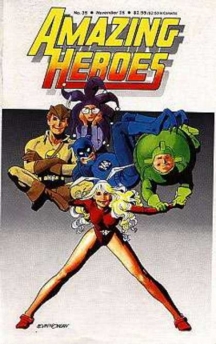In the first part of this “series” I talked about the state of the comic industry that Malibu was born into. In the second part I talked about my personal path prior to the birth of Malibu. In the third part, I talked about 1986, the year that Malibu was born and some of the things that came together at Sunrise Distribution that would be instrumental in Malibu’s success.

Kevin Nowlan's cover to one of the first AH issues that Tom and I worked on together. (issue #35: featuring The Inferior Five)
In part four, I’m going to talk mostly about Tom Mason. I’d met Tom the first day I worked at Fantagraphics Books. I had been hired to be the managing editor of Amazing Heroes magazine. That first day on the job in Connecticut, I was introduced to Tom, who was the art director for Amazing Heroes. We worked together closely. We became friends in Connecticut and when Fantagraphics Books move to Sourthern California, both Tom and I were along for the ride (and keeping our jobs).
STARTIN’ FROM SCRATCH WITHOUT ANY SCRATCH
It is a common and time honored tradition that employees bitch about their employers. They compare notes and speculate how things would be different if they were in charge. This was a regular and vigorous source of discussion in the halls of Fantagraphics Books; Tom and I were active participants. If wishes were fishes …

Tom Mason 2008
When I realized that Scott Rosenberg was serious about his offer to let me run a comic publishing company that he would finance, my first phone call went to Tom Mason. He immediately became my sounding board, my confidant, my advisor. It was less than two days after that initial phone call that Tom and I met on opposite sides of a outdoor table at a Jack-in-the-Box restaurant on Kanan Road in Agoura Hills, California.
In the sweaty heat of that summer afternoon, Tom and I talked about how to start, set-up, and promote a new comic book company. We talked about all the things that other publishers did that we wanted to emulate. We talked about how much we could do and how quickly we would do it. The most important thing we talked about were the mistakes we saw other publishers making that we wanted to avoid. Tom took out a notepad, which he always carried with him (mostly to draw cartoon bears and birds) and we started writing down the steps that we needed to take and the order in which things needed to happen to get this unnamed publishing company up and running as quickly as possible.

JONNY QUEST #5 (cover by Dave Stevens) was released while Tom and I made our plans about how to set up the new comic publisher.
Even after our meeting was over, we simply could not stop thinking and talking about this extraordinary opportunity. Tom and I talked every day, coming up with new ideas, tweaking other ideas, and trashing ideas that wouldn’t work. I still had my responsibilities at Sunrise Distribution, making sure that retailers got the comics they needed to sell in their stores. Tom would show up at the Sunrise warehouse about once-a-week for a lunch talk.
As I talked about in Part Three, the new emerging desktop printing technology, specifically the Apple Macintosh and the Apple Laserwriter, was changing how magazines were created. We were busy figuring out how that could change comics publishing. Every weekly visit would include lunch and then Tom and I would spend time figuring out exactly how much time, effort and cost this new computer system could save Malibu.
It was obvious that we were going to need to pinch every penny and take every cost cutting measure possible if Malibu had any chance of success. As we were ramping up, the comic industry was spinning downward. There were people that thought starting Malibu when we did was completely foolhardy. “You couldn’t have picked a worse time to start a publishing company,” was a common comment I heard from people in the business. And I heard it from people that I really didn’t want to hear it from … like distributors and retailers.

Tom (left) and DWO (right) in San Diego 2008
We were moving as fast as we could. We both had to keep all our other responsibilities covered, while we planned Malibu in our meager spare time. Even though others were telling us it was a bad idea, we continued to move forward with a “no time like the present” philosophy.

We were getting submissions ...
I put together budgets and worked on writing and constructing the contracts that would be offered to creators. Meanwhile Tom spent a lot of time talking to creative people about the possibility of being published by a new start-up black-and-white publisher called Malibu Graphics (somehow “graphics” seemed a little more mature and little more inclusive than the word “comics”).
We started to get submissions. We talked to everyone that would listen. Considering the state of the industry, there were a lot of creators who weren’t willing to take a chance on a new start-up. There were others that weren’t willing to work for the meager rates that Malibu could offer. It became clear that this wasn’t going to be easy, but we were still confident in our ability to compete in the direct market.

...but would creators work for our low rates?
Then we took our plans to Scott Rosenberg. He was extremely supportive and helpful. And then he shared the news that we couldn’t afford an office. Malibu was homeless. Tom and I suddenly faced a new challenge that we hadn’t really considered.
That’s my version of the story.
IN PART FIVE … WE FIND A HOME IN A VERY UNLIKELY PLACE … BUT FOR THE RIGHT PRICE.
— Dave Olbrich (DWO) Mon. March 2, 2009









“You couldn’t have picked a worse time to start a publishing company.”
I think you’re going to hear that no matter when you start something new. Glad you guys pressed ahead, as it gave me an opportunity to write all sorts of weird and wonderful books for you guys. I went broke in the process but gained a different kind of riches.
I love the Jonny Quest cover … that was actually a decently-written book. And I have a secret emotional attachment to that particular cover that I’d reveal if it wouldn’t result in divorce.
Your initial phone call came at one of those “only-happens-in-movie” moments where the timing couldn’t have been better. I’d just had an impromptu job interview with Rick Oliver from First Comics at the San Diego Con that year; we bumped into each other at a panel Steve Rude was on and started talking. (After the con, I remember giving both Rude and Heidi MacDonald a ride back to L.A.) Anyway, Oliver offered me a job at First and flew me out to Chicago to tour the offices, meet everybody and check out the town. It was a nice offer (plus I got to hold some original Howard Chaykin American Flagg! pages in my hands), but I couldn’t see leaving California and finding happiness in a Chicago winter. Staying in L.A. and being a part of something from the beginning was an easier choice.
Odd.
I’m sure that at some point, the information about you and Rick Oliver and your trip to Chicago must have been something I knew. And yet I read this as if I had no memory of it whatsoever.
But then, that’s part of the goals of this blog, to bring together all the information like an enormous jigsaw puzzle and putting as many pieces in place as possible.
I’m glad things worked out the way they did.
“This is the reason that almost all of my posts here end with the caveat, ‘That’s my version of the story.’ It is a way for me to acknowledge that my memory isn’t perfect and even if I remember it clearly, others memory of exactly the same situation may be different.” – Dave Olbrich
Perhaps this should be the opening paragraph to your Wikipedia entry? :)
Yeah, well, what are you gonna do.
Unfortunately, just like you, I don’t have a Wikipedia entry yet. But that might be a good start.
You guys are just so cool! Malibu sounds like it was just the most awesome company! Can’t wait to hear more!
Ladies and gentlemen … the witty, the wonderful, the snarky editor-in-chief of Malibu Comics … Mr. Chris Ulm.
You wanna tell your side of the story … just let me know. And get yourself a cup of coffee … you’re getting cranky.
Pingback: Robotech, Grendel featured in this week’s Fanatic Quiz Question « Funny Book Fanatic
Geez…why don’t you guys get a room!
I’m enjoying this very, very much. Please continue — or, better yet, find a publisher. I’d love to read an in-depth history of MALIBU.
There is more Secret Origins of Malibu coming in future weeks … so stay tuned.
Pingback: Zac Efron and Dwayne “The Rock” Johnson in JONNY QUEST … or not? « Funny Book Fanatic
I’ve been lurking and reading and waiting…and waiting…for part 5….
Pingback: In honor of reaching 50,000 page views, we take a trip down memory lane. « Funny Book Fanatic
Reading this has really been fantastic, I can’t wait to hear more. Back in the day I was a big Malibu fan and this is a great insight to a company I admired so much. Once again I can’t thank you enough for posting this, it is a true treasure.
Where may I find part 5?
Please let me know.
Thanks.
We need part five, Dave!
Did part 5 ever come out?